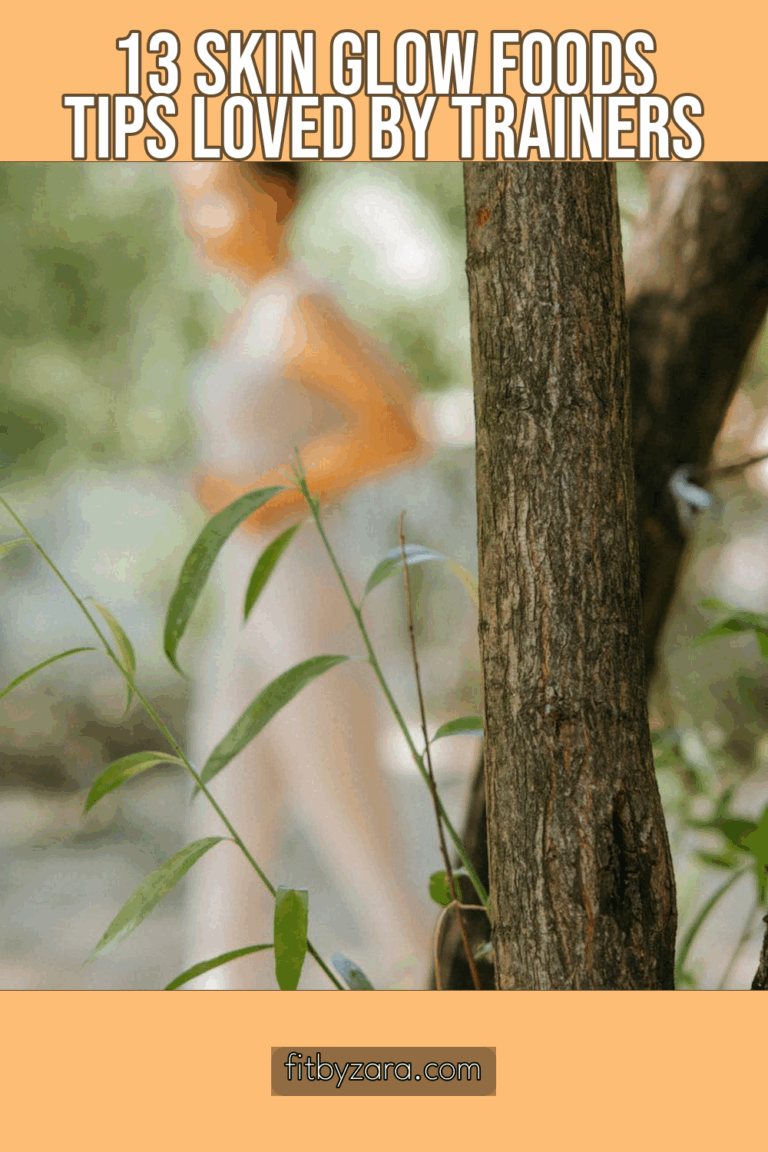Hey there, glow-getters! If you’re over 30 and looking to up your skin game, you’re in the right place. As we age, our skin can sometimes lose its radiance, but don’t worry—there are plenty of delicious foods that can help you shine from the inside out. In this blog post, we’re diving into 13 skin glow foods that trainers swear by, presented in an easy-to-follow mini workout format. Let’s get glowing, ladies!

Hi, I’m Zara — fitness junkie, wellness nerd, and the voice behind FitByZara.com. This site is all about smart fitness and science-backed wellness tips for real women who want to feel their best.
Warm-Up: The Importance of Nutrition for Skin Health
3-Day Energy & Metabolism Reset
Grab the 3-Day Energy & Metabolism Reset — a quick-start guide to feel lighter, more energized, and back in control.

Where should I send your free reset guide?
Before we jump into the juicy details, let’s talk about why nutrition matters for your skin:
- Hydration: Your skin needs water to stay plump and radiant.
- Nutrients: Vitamins and minerals play a crucial role in skin health.
- Antioxidants: These powerhouses help protect your skin from oxidative stress.
“Your skin is your largest organ; treat it well with the right foods, and it will thank you with a radiant glow.”
—
Mini Workout: 13 Skin Glow Foods Tips
1. Berry Blast Workout
Key Ingredients: Blueberries, Strawberries, Raspberries
- Why They’re Great: Packed with antioxidants, berries can help combat free radicals and promote collagen production.
- How to Incorporate:
– Blend them into your morning smoothie.
– Top your yogurt with a handful of mixed berries.
– Add them to your oatmeal for a sweet kick.
Mini Checklist:
- [ ] Add 1 serving of berries to your breakfast.
- [ ] Snack on berries during the day.
2. Leafy Greens Circuit
Key Ingredients: Spinach, Kale, Swiss Chard
- Why They’re Great: These greens are rich in vitamins A, C, and K, which support skin health and repair.
- How to Incorporate:
– Toss them in salads.
– Blend into smoothies.
– Sauté with olive oil and garlic for a quick side dish.
Mini Checklist:
- [ ] Include leafy greens in at least 2 meals per day.
- [ ] Experiment with a new leafy green this week.
3. Avocado Crunch
Key Ingredients: Avocado
- Why They’re Great: Creamy and delicious, avocados are loaded with healthy fats and vitamins E and C, which hydrate and protect the skin.
- How to Incorporate:
– Smash on whole-grain toast.
– Blend into smoothies for creaminess.
– Use in salads for a nutrient boost.
Mini Checklist:
- [ ] Have avocado at least 3 times this week.
- [ ] Try a new avocado recipe (like guacamole!).
4. Citrus Sprint
Key Ingredients: Oranges, Lemons, Grapefruits
- Why They’re Great: High in vitamin C, citrus fruits promote collagen production and help brighten your skin.
- How to Incorporate:
– Start your day with a citrus-infused water.
– Add to salads for a zesty twist.
– Make a refreshing smoothie.
Mini Checklist:
- [ ] Drink citrus-infused water daily.
- [ ] Add a citrus fruit to your diet 3 times a week.
5. Nutty Power-Up
Key Ingredients: Almonds, Walnuts, Brazil Nuts
- Why They’re Great: Nuts are rich in healthy fats, vitamin E, and antioxidants, which help nourish your skin.
- How to Incorporate:
– Snack on a handful of nuts.
– Add to salads or smoothies.
– Use nut butter on toast or in smoothies.
Mini Checklist:
- [ ] Include a handful of nuts daily.
- [ ] Try a new nut butter this week.
6. Sweet Potato Strength
Key Ingredients: Sweet Potatoes
- Why They’re Great: Packed with beta-carotene, sweet potatoes can help keep your skin smooth and youthful.
- How to Incorporate:
– Roast as a side dish.
– Mash with a bit of olive oil and spices.
– Add to soups or stews.
Mini Checklist:
- [ ] Roast sweet potatoes this week.
- [ ] Try a sweet potato dish for dinner.
7. Seaweed Stretch
Key Ingredients: Nori, Dulse, Kombucha
- Why They’re Great: Sea vegetables are rich in minerals and have hydrating properties that can improve skin elasticity.
- How to Incorporate:
– Use nori sheets for sushi.
– Add dulse flakes to salads.
– Try kombucha for a gut-friendly drink.
Mini Checklist:
- [ ] Incorporate seaweed into your meals twice this week.
- [ ] Experiment with a new seaweed dish.
8. Whole Grain Flex
Key Ingredients: Quinoa, Brown Rice, Oats
- Why They’re Great: Whole grains are full of fiber and nutrients that support healthy skin and digestion.
- How to Incorporate:
– Use quinoa as a base for salads.
– Enjoy brown rice with stir-fries.
– Start your day with oatmeal topped with fruits.
Mini Checklist:
- [ ] Swap refined grains for whole grains.
- [ ] Try a new whole grain recipe this week.
9. Dark Chocolate Delight
Key Ingredients: Dark Chocolate (70% or higher)
- Why They’re Great: Rich in antioxidants, dark chocolate can boost skin hydration and improve texture.
- How to Incorporate:
– Enjoy a square as a treat.
– Melt and drizzle over fruit.
– Add cacao powder to smoothies.
Mini Checklist:
- [ ] Treat yourself to dark chocolate a couple of times a week.
- [ ] Get creative with cacao in your recipes.
10. Fishy Focus
Key Ingredients: Salmon, Mackerel, Sardines
- Why They’re Great: Fatty fish are loaded with omega-3 fatty acids, which help keep your skin moisturized and reduce inflammation.
- How to Incorporate:
– Bake or grill fish for dinner.
– Add canned sardines to salads.
– Make a salmon salad for lunch.
Mini Checklist:
- [ ] Eat fatty fish at least twice a week.
- [ ] Try a new fish recipe.
11. Spicy Boost
Key Ingredients: Turmeric, Ginger, Cayenne
- Why They’re Great: Spices like turmeric and ginger have anti-inflammatory properties that can benefit your skin.
- How to Incorporate:
– Add turmeric to soups or curries.
– Make ginger tea for a refreshing drink.
– Use cayenne pepper in savory dishes.
Mini Checklist:
- [ ] Incorporate a new spice into your cooking this week.
- [ ] Try making a spice-infused drink.
12. Hydration Station
Key Ingredients: Water, Herbal Teas, Coconut Water
- Why They’re Great: Staying hydrated is key to maintaining skin elasticity and glow.
- How to Incorporate:
– Carry a water bottle and refill throughout the day.
– Enjoy herbal teas as a warm drink.
– Use coconut water in smoothies or as a refreshing beverage.
Mini Checklist:
- [ ] Drink at least 8 glasses of water daily.
- [ ] Add herbal tea to your routine.
13. Fermented Friends
Key Ingredients: Yogurt, Kefir, Sauerkraut
- Why They’re Great: Fermented foods are great for gut health, which can reflect on your skin.
- How to Incorporate:
– Include yogurt in your breakfast or snacks.
– Add sauerkraut to salads or sandwiches.
– Try kefir in smoothies.
Mini Checklist:
- [ ] Incorporate a fermented food into your meals 3 times this week.
- [ ] Experiment with a new recipe using fermented ingredients.
—
Cool Down: Putting It All Together
So there you have it—13 skin glow foods that can help you shine bright as you navigate your 30s and beyond. By incorporating these foods into your diet, you’ll be well on your way to achieving that radiant glow we all desire.
Final Thoughts
Remember, consistency is key. Start by incorporating a few of these tips into your daily routine, and you’ll soon see the benefits. Your skin will thank you, and you’ll feel empowered knowing you’re nourishing your body with the best.
Keep it chill, keep it real, and keep glowing! ✨
—
What are your go-to skin glow foods? Share in the comments below!
HepatoBurn: Gentle Support for Steadier Days
When you’re stacking real habits—protein-forward meals, steps, and 7–9 hours of sleep—HepatoBurn is a simple add-on that supports the system behind energy, appetite, and metabolic rhythm.
Why Women 30+ Use It
- Pairs with an already-solid routine—no jitters, no crash.
- Easy to remember: 2 capsules with meals.
- Plays well with protein, walking, and strength training.
How to Use
- Timing: Breakfast & lunch are easy wins.
- Consistency: Use daily for a fair assessment.
- Stacks: Protein-first plates, post-meal walks, lights-down wind-down.
What It Isn’t
- Not a stimulant and not a magic fix.
- Best used alongside habits you’ll actually keep.
- Educational only—talk to your provider before new supplements.
Important: Educational only, not medical advice. Supplements don’t diagnose, treat, cure, or prevent diseases. Talk to your provider before changes to diet, exercise, or supplements.






















